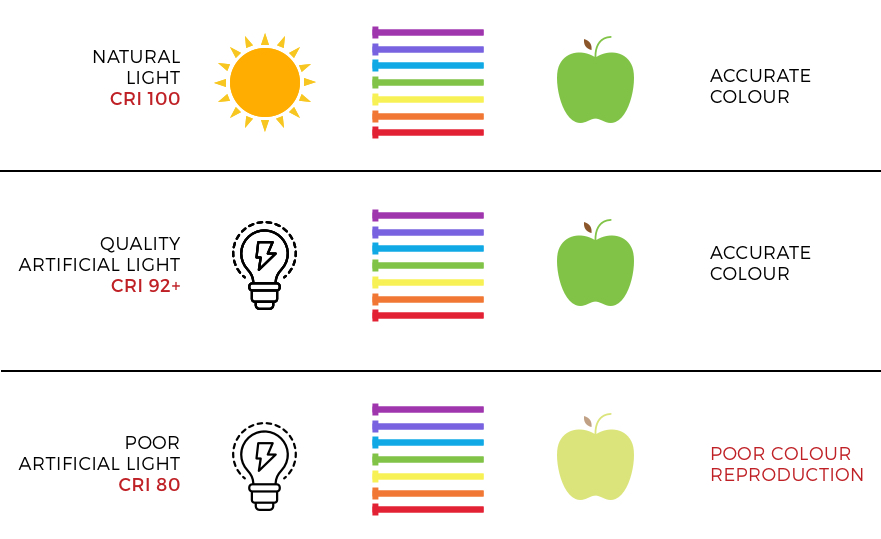A guide to LED colour science
By Radiant Lighting | 30 Nov 2021 | 0 Comments
Much of the discussion surrounding LED’s has been on energy efficiency and components but light quality and colour must be addressed. In this article, we will answer some questions such as what is the Colour Rendering Index and how efficiency can impact colour reproduction.
What is Colour Rendering Index (CRI)?
While we have touched on CRI in previous posts, we’ll use this opportunity to dive deep into what exactly is the CRI metric.
In short, CRI measures the ability of a light source to accurately reproduce the colours of the object it illuminates. It is measured on a scale of 0-100 where 100 is the highest possible score. Natural outdoor light will achieve a score of 100 so essentially, we’re using CRI to benchmark artificial lights against sunlight.
For example, looking at a green apple in daylight, you would see a vibrant green apple because all colours of the light spectrum are being absorbed, except green, which it reflects back. Take that same green apple, and look at it under a poor quality artificial LED light, it might be lacking in that vibrant green colour because the lamp itself is lacking green. When the light bounces off the apple, there is no green light to reflect. On the flipside, a high quality LED would be able to replicate natural light and you would see the apple in all it’s green glory. See the illustration below.

Without getting into the technical details of how the number is measured, it is in fact this difference that we are interested in. Sometimes, the reproduced colour will appear quite similar, other times quite different. It is this similarity that CRI is measuring.
What does that mean you should buy?
Almost always you should choose the LED with a higher CRI. 92 and above is our recommendation.
I’ve heard that high CRI means less lumens
The relationship between CRI and lumens/efficiency is frequently noticed but can be misunderstood. Keep reading to learn why.
Lumens are the metric to describe the brightness of a light source. It is a metric developed by scientists in the early 20th century which determines what frequency of light our eyes are most sensitive too and how much energy is present in those frequencies. These scientists established red, violet and blue wavelengths are very ineffective at appearing bright but colours like green and yellow are very good at appearing bright.
CRI is a metric which rewards delivering colours across the entire spectrum whereas lumens will be increased when you focus on a narrow spectrum of light. This is why
high CRI LED’s will generally produce less lumens than a lower-CRI/standard cool-white light.
In the pursuit of energy efficiency, you will lose colour quality which is why you must pick the appropriate lighting for certain applications. Outdoor lights might not need to have such a high CRI because you’re simply trying to light up a space whereas indoor lighting should have a strong focus on CRI.
Colour Temperature
Selecting the correct colour temperature when searching for an LED is very important! Colour temperature describes how ‘warm’ or ‘cool’ a light is. In terms of it’s spectrum, we can also understand it as the relative balance between yellow/orange colours vs white/blue colours.
You might see it described as color temperature, CCT or Kelvin rating. With so many options, it can seem overwhelming at first but here are some rough guidelines.
2700K
Warm look of a traditional incandescent bulb
Good for living rooms and bedrooms
Yellow/Orange
3000K
Relaxed and inviting atmosphere with a little less yellow
Good for kitchens and dining areas
4000K
Neutral, balanced colour that is more crisp than the previous without being harsh
Good for retail stores, hotel lobbies and common areas
Less yellow, moving to white
5000K
Balanced white colour that is similar to daylight
Good for work environments with visually demanding tasks
6500K
True match for daylight – very white and pushing towards blue
Good for art production, photography and calibrated work
Any questions?
We hope you enjoyed reading the guide today. If you have any questions at all surrounding CRI, colour science and all things lighting related, our team of lighting consultants are here to assist. Feel free to contact us on 08 9240 2227 or by email at sales@radiantlighting.com.au
Back To Blog Entries